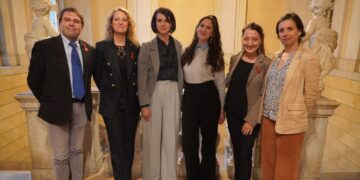During the last decade asthma and allergic rhinitis increased substantially in Italy, particularly in Verona. The researches carried out by the so-called SEMS – Section of Medical Statistics and Epidemiologyofthe University of Verona – confirmed the following data: the impact of asthma passed from 4,1% to 6,6% and allergic rhinitis registered an increment from 17 % to 24,2%. The SEMS organised a congress called “Primo congresso internazionale sulle grandi indagini di popolazione italiane ed europee sulla salute respiratoria” (Large scale population-based surveys on respiratory health in Italy and Europe) in collaboration with the Italian Association of Hospital Pneumologists, the Italian Association of Epidemiology and the Italian Society of Medical Statistics and Clinical Epidemiology. Allergy specialists, pulmonary specialists, internal medicine specialists, cardiology specialists, paediatric specialists, biologists, chemists, epidemiologists, hygienists, researchers and public sanity experts were present during the congress in order to define the main results of children and adults-based epidemiological studies on respiratory healh in Italy and Europe. The scientific coordinators of the event were Roberto de Marco as the Director of the so-called SEMS, Andrea Rossi as a Pneumologist of the University of Verona and Giovanni Viegi as the Director of the Biomedicine and Molecular Immunology of the Cnr of Palermo.
De Marcoexplained: “The congress was organised because authorities, sanitary experts and the public opinion are not entirely aware of the social and sanitary impact of the respiratory diseases, despite the topical knowledges. The research has to make great progress in order to understand which are the genetic and environmental factors that can determine the risk of diseases and of the seriousness of the disease.” .
Viegiaffirmed: “Indeed, the aim of the meeting is to convey an important message: deep population-based studies are needed in order to study the natural history of the respiratory diseases well. It’s also necessary to conduct studies on samples representative of reality. This research will take much time, but will guarantee reliable results.” .
Air pollution and diseases in Verona.The researchers of the so-called SEMS state “As the other big towns of the Pianura Padana, Verona is characterised by a high level of environmental pollution. Nitrogen oxides, dust and pollution particles tend to remain “trapped” in the soil due to the features of the Pianura Padana and because of the weak ventilation for a long time. Nitrogen oxides, dust and pollution particles are due to a high level of transport-related air pollution (in Europe Italy has reached second place after Luxembourg for the number of cars for each inhabitant) and because of the emissions from factories and houses. For this reason we are searching to analyse the link between the atmospheric pollution and the respiratory health. Our research focuses also on the genetic factors which are the greater causes of the development and the evolution of the respiratory diseases together with the environmental factors.” .
From more than twenty years the Verona research team, which is a high quality research team at the national scale,isstudying the diffusion and the risk factors of the most common chronic repiratory diseases, such as asthma, chronic bronchitis, chronic obstructive pulmonary disease and allergic rhinitis. Roberto de Marco is the national coordinator of the Ecrhs, the most important survey of the respiratory health in Europe and he co-ordinates national surveys of the role of genes and the effect of the environment on respiratory health. In addition, from more than ten years the University group of Environmental Epidemiology , whose coordinator is Alessandro Marcon, studies the evaluation of the impact of the industry pollution on health. The group, co-ordinated by the Medical Statistics researcher, conducts important epidemiological surveys both in Verona and on the Mantuan territory.
Andrea Rossi added:“When a disease is very diffuse, we can’t face it with the help of the so-called Expectation Medicine, but rather with the help of the so-called Medicine Initiative. For this reason doctors and authorities have to shift their attention on this second aspect, in order to carry out early social prevention plans.
03.11.2014
























